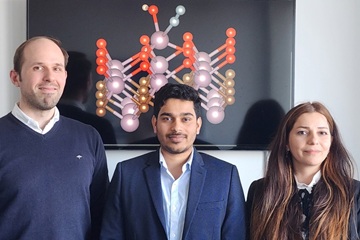Selective nitrogen reduction reaction at electrochemically formed monoatomic centers of molybdenum-based MXenes
New solution for an acute selectivity problem

©Exner
Prof. Dr. Kai S. Exner (left), Diwakar Singh (middle), and Shohreh Faridi (right) are part of the team working on this project. Missing from the picture: Dr. Samad Razzaq. The picture on the screen shows how the MXene-SAC motif activates dinitrogen (N2) for electrochemical ammonia synthesis.
The electrocatalytic reduction of dinitrogen is a promising route to the sustainable production of ammonia, although the problem of selectivity of the competing nitrogen reduction and hydrogen evolution reactions in aqueous electrolytes has not yet been solved. Single-atom catalysts (SACs) offer the prospect of bridging this gap, as they have a unique electronic structure and reactivity in catalytic conversions compared to conventional bulk materials. In a recent article published in Materials Today, it was shown that in-sit uformed single-atom centers on molybdenum-based MXenes can direct selectivity to the preferred product ammonia by pulsing the electrochemical potential, providing a new route to overcome selectivity in nitrogen reduction.
Single atom catalysts (SACs) have developed into a new class of materials that can be used to produce active and selective catalysts. In most cases, this means that a - usually precious - transition metal is anchored to some kind of support. Researchers led by Materials Chain Member Prof. Dr. Kai S. Exner recently reported that MXenes - a class of two-dimensional materials first discovered in 2011 - are capable of forming in-situ SAC-like sites when an anodic electrode potential is applied. This discovery can greatly simplify the production of single-atom catalysts and eliminates the need for expensive precious metals.
Now Exner and his team have shown that the SAC-like sites of MXenes can also efficiently catalyze nitrogen reduction under cathodic conditions. "We came to the conclusion that molybdenum-based MXenes have the potential to steer selectivity towards the preferred product ammonia," explains Exner. Exner and his team came to this conclusion through electrochemical pulse experiments in which the applied electrode potential circulates between a working potential and a resting state.
Original publication:
Singh, D.; Razzaq, S.; Faridi, S.; Exner, K.S. Selective Nitrogen Reduction Reaction on Single-Atom Centers of Molybdenum-Based MXenes by Pulsing the Electrochemical Potential. Mater. Today 2025, DOI: 10.1016/j.mattod.2025.03.016.
